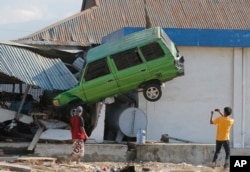Desperation was visible everywhere Tuesday among victims receiving little aid in areas heavily damaged by a massive earthquake and tsunami, four days after the disaster devastated parts of Indonesia's central Sulawesi island. Signs propped along roads read "We Need Food'' and "We Need Support,'' while children begged for cash in the streets and long lines of cars snarled traffic as people waited for fuel.
Teams were searching for trapped survivors under destroyed homes and buildings, including a collapsed eight-story hotel in the hard-hit city of Palu, but they needed more heavy equipment to clear the rubble.
Desperation was evident across Palu, a city of more than 380,000 people that was hard-hit by both the quake and the tsunami, its force apparently magnified in the surrounding inlet.
Many people were believed trapped under shattered houses in Palu's Balaroa neighborhood, where the earthquake caused the ground to heave up and down violently, said disaster agency spokesman Sutopo Purwo Nugroho.
"I and about 50 other people in Balaroa were able to save ourselves by riding on a mound of soil which was getting higher and higher,'' resident Siti Hajat told MetroTV, adding her house was destroyed.
In the Petobo neighborhood, the quake caused loose, wet soil to liquefy, creating a thick, heavy mud that caused massive damage. "In Petobo, it is estimated that there are still hundreds of victims buried in mud,'' Nugroho said.
Residents who found loved ones - alive and dead - over the weekend expressed frustration that it took rescue teams until Monday to reach Petobo.
The confirmed death toll of 844, mostly from Palu, is expected to rise as authorities reach cut-off areas. The regencies of Donggala, Sigi and Parigi Moutong - with a combined population of 1.2 million - had yet to be fully assessed. The magnitude 7.5 earthquake struck at dusk Friday and generated a tsunami said to have been as high as 6 meters (20 feet) in places.
About 3,000 residents flocked to Palu's airport, trying to board military aircraft or one of the few commercial flights using the facility only partially operating due to damage. Video showed some of them screaming in anger because they were not able to get on a departing military plane.
"We have not eaten for three days!'' one woman yelled. "We just want to be safe!''
Nearly 50,000 people have been displaced from their homes in Palu alone, Nugroho said, and hospitals were overwhelmed.
The Indonesian air force confirmed that a Hercules aircraft carrying an unspecified number of survivors was able to leave Palu for South Sulawesi's capital of Makassar.
Indonesian President Joko "Jokowi'' Widodo authorized the acceptance of international help, Nugroho said, adding that generators, heavy equipment and tents were among the most-needed items. The European Union and 10 countries have offered assistance, including the United States, Australia and China, he said.
"We will send food today, as much as possible with several aircraft,'' Widodo told reporters in the capital, Jakarta, adding that a supply of fuel was also set to arrive.
The coastline at Palu was strewn with rubble and a few brightly colored cargo containers poking out of the water. Buildings near the water were ruined shells. The arches of a large yellow bridge rested in the water and eerie drone footage showed a Ferris wheel, untouched, on a beach scraped bare by the waves.
Rescuers searching a collapsed building Monday night were able to remove 38-year-old Sapri Nusin alive from the rubble. He was talking to his rescuers as they took him away but his condition was not known.
In the Petobo neighborhood, Edi Setiawan said he and his neighbors rescued children and adults, including a pregnant woman. His sister and father, however, did not survive.
"My sister was found embracing her father,'' he said. "My mother was able to survive after struggling against the mud and being rescued by villagers.''
Indonesia is frequently struck by earthquakes, volcanic eruptions and tsunamis because of its location on the "Ring of Fire,'' an arc of volcanoes and fault lines in the Pacific Basin. A powerful quake on the island of Lombok killed 505 people in August.
The vast archipelago has more than 17,000 islands home to 260 million people. Roads and infrastructure are poor in many areas, making access difficult in the best of conditions.











